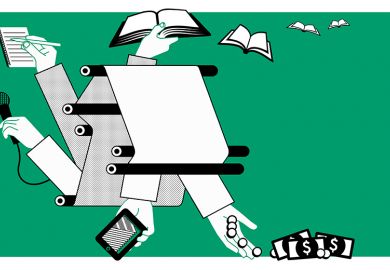A survey has found that three-quarters of students would prefer to use physical books over ebooks for their studies.
The survey of 741 students across UK universities, conducted by the bookseller Blackwell’s, asked respondents: “If each of the following resources – printed textbooks, ebooks or digital courseware – is made available to you free of charge, which would you prefer to use in your studies?”
The responses to the Learning Resource Survey 2019-20 showed that 76 per cent of respondents said they preferred printed textbooks, compared with 18.5 per cent who chose ebooks and 5.5 per cent who said digital courseware.
Blackwell’s also surveyed lecturers and found that, when asked about the advantages of either paper textbooks, ebook textbooks or digital courseware, they saw the most educational value in textbooks.
The results from 364 lecturers showed that respondents rated physical textbooks the highest for concentration, education outcomes and ease of annotation and note-taking. Ebooks and digital courseware received higher ratings only for “accessibility”.
Asked if they used textbooks in their teaching, 88 per cent of lecturers responded “yes”. They were also asked which other resources they used, and the results showed a wide range of reading tools being used. The most popular answer was journal articles, followed by course notes on the virtual learning environment, library ebooks and library textbooks.
The survey also showed that academics underestimated the value students placed on physical books, as only 48 per cent guessed this was their preferred learning resource.
Will Williams, head of academic sales at Blackwell’s, said that even he was surprised by just how clear the preference was.
“We hear so much noise around edtech and digital initiatives, it can be overwhelming,” he said. “But the results show undoubtedly that physical textbooks are still seen by lecturers and students as the preferred resource.”
Students now have the opportunity for a much more “engaging and exciting experience” as lecturers are able to tap into a wide variety of resources, Mr Williams said. “But at the end of the day, when some serious study needs to be done, the physical textbook remains the most important [resource].”
The results are backed up by a 2016 study by Naomi Baron, professor of linguistics and executive director of the Center for Teaching, Research and Learning at the American University in Washington DC, which found that 92 per cent of US students preferred paper resources.
Yet the ebook has proved popular and in high use. In February, Pearson, the education publisher, said that sales of physical books declined 30 per cent in 2019 and that half of all learners now prefer ebooks.
Price is perhaps the most likely reason for such a finding, Mr Williams said, adding that cost would always be important for students. “For us, that’s why it was important to identify what their preference was when cost was removed as a factor,” he said. “We’re realistic that [the textbook] is part of a varied mix for independent and engaged learning for students.”
Register to continue
Why register?
- Registration is free and only takes a moment
- Once registered, you can read 3 articles a month
- Sign up for our newsletter
Subscribe
Or subscribe for unlimited access to:
- Unlimited access to news, views, insights & reviews
- Digital editions
- Digital access to THE’s university and college rankings analysis
Already registered or a current subscriber?








